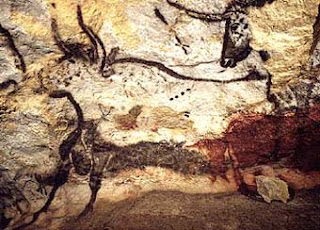The extremes of selective breeding in dogs...
...from the Gray Wolf.
There are almost 10,000 species of birds and over 4,000 species of mammals in the world. Possibly less than 30 of these animals have truly been domesticated! The idea of domesticated animals has intrigued me for some time. I thought it would be interesting to study what these domesticated animals are, when were they domesticated, where did they come from, and do the wild forms still exist today and where.
Painting of the extinct Aurochs from a cave in Lascaux. France.
This is the ancestor of modern domestic cattle...
...and humans develop the Dexter Cattle (pictured full grown)...
...and the huge, double-muscled, Belgian Blue Cattle!
It is truly amazing how some animals have been selectively bred for hundreds to thousands of generations to become what they are today, and that typically means filling a very specific niche for us humans.
Take the Red Jungle Fowl, ancestor to all modern chickens...
...and we develop the Silkie Chicken!
It seems odd that given all the animals on this earth that so few can be considered domestic. Humans have been able to “tame” a lot of wild animals, but if given the choice tame animals would escape and become wild again. True domestication is actually a rare event in the history of the world.
For an animal to be domestic, it has to meet six criteria as defined by Jared Diamond, scientist, author, and Pulitzer Prize winner:
- The animal has to be willing to consume a wide variety of food sources - typically food that is not utilized by humans (pigs) or food that makes it more cost effective to feed than hunt the wild animal (sheep, cattle) or more beneficial to feed the animal to keep it around for the benefits it brings us (dogs).
- The animal has to grow fast. An elephant takes 15 years to mature while a chicken takes under 10 months. Much more selective breeding can take place with chickens than elephants.
- The animal must breed in captivity. This again goes back to selective breeding programs.
- The animal must be pleasant. All attempts to domesticate zebras, bison, and African buffalo have failed here.
- The animal should not panic easily. This is where deer have lost it.
- The animal must accept humans as the top of their social structure. This is why many do not consider cats truly domestic.
Here is a list of the world's main domestic animals. I am sure there are a few animals not included here that should be in this list. I did the best I could to verify the dates of domestication and the wild ancestor. I did not include certain animals due to their being so close to the wild version (Peafowl, Mute Swans, Barbary Doves, Zebu, Asian Elephants) or not really agricultural species (Canaries, Lab Rats/Mice). I also did not include species that are often considered domestic due to human use (Honey Bees, Silkworms) or because they have undergone such intensive selective breeding (Goldfish, Koi, Domestic Carp), because they do not or cannot accept humans as the top of their social structure (see above).
ANIMAL WHEN ANCESTOR WHERE FOUND WILD TODAY
Dog Early Man Wolf/Jackal Europe, Africa, North America
Sheep ~10,000 BC Mouflon/Urial Southwest Asia
Pig 9,000 BC Wild boar China, Near East, European forests
Goat 8,000 BC Wild goat Asia, Mediterranean, Europe
Cattle 8,000 BC Aurochs Extinct - origin Europe, Asia, N. Africa
Cat 7,500 BC African Wildcat Africa
Chicken 6,000 BC Red jungle fowl India, Asia
Guinea Pig 5,000 BC Cavia South America
Donkey 5,000 BC African Wild Ass Africa
Duck 4,000 BC Wild Duck Worldwide
Water Buffalo 4,000 BC Wild Water Buffalo Asia
Horse 4,000 BC Wild Horse Eurasian Steppes
Dromedary 4,000 BC Wild Camel Only wild population are feral in Australia
Llama 3,500 BC Wild Llama/Guanaco Mountains of South America
Reindeer 3,000 BC Wild Reindeer/Caribou Far northern North America, Asia, Europe
Pigeon 3,000 BC Wild Rock Pigeon Worldwide
Goose 3,000 BC Greylag Goose Europe, Asia, Africa
Goose 3,000 BC Greylag Goose Europe, Asia, Africa
Bactrian 2,500 BC Wild Camel Small population in NW China, Mongolia
Yak 2,500 BC Wild Yak Small population in Tibet, China, India
Ferret 2,000 BC European Polecat None
Ferret 2,000 BC European Polecat None
Alpaca 1,500 BC Vicuna None
Turkey 500 BC Wild Turkey North America
Bali Cattle Unknown Benteng Southeast Asia
Gayal Unknown Gaur South and Southeast Asia
Muscovy Duck Unknown Wild Muscovy Duck Mexico, Central, and South America
Guineafowl Unknown Wild Guineafowl Africa
Rabbit Unknown European Rabbit Europe








I’d like to thank you for the efforts you’ve put in writing this blog.
ReplyDeleteI’m hoping to view the same high-grade content by you later on as well.In truth, your creative writing abilities has inspired me
to get my own blog now.
I am very thankfull to you for sharing this fantastic article , I appereciate your work avg.com/retail
ReplyDeletewww.avg.com/retail
avg.com/activation